3-Day Backpacking Checklist (with Printable Packing List)
This complete backpacking checklist includes all the lightweight gear you’ll need when packing for an overnight trip in the backcountry.
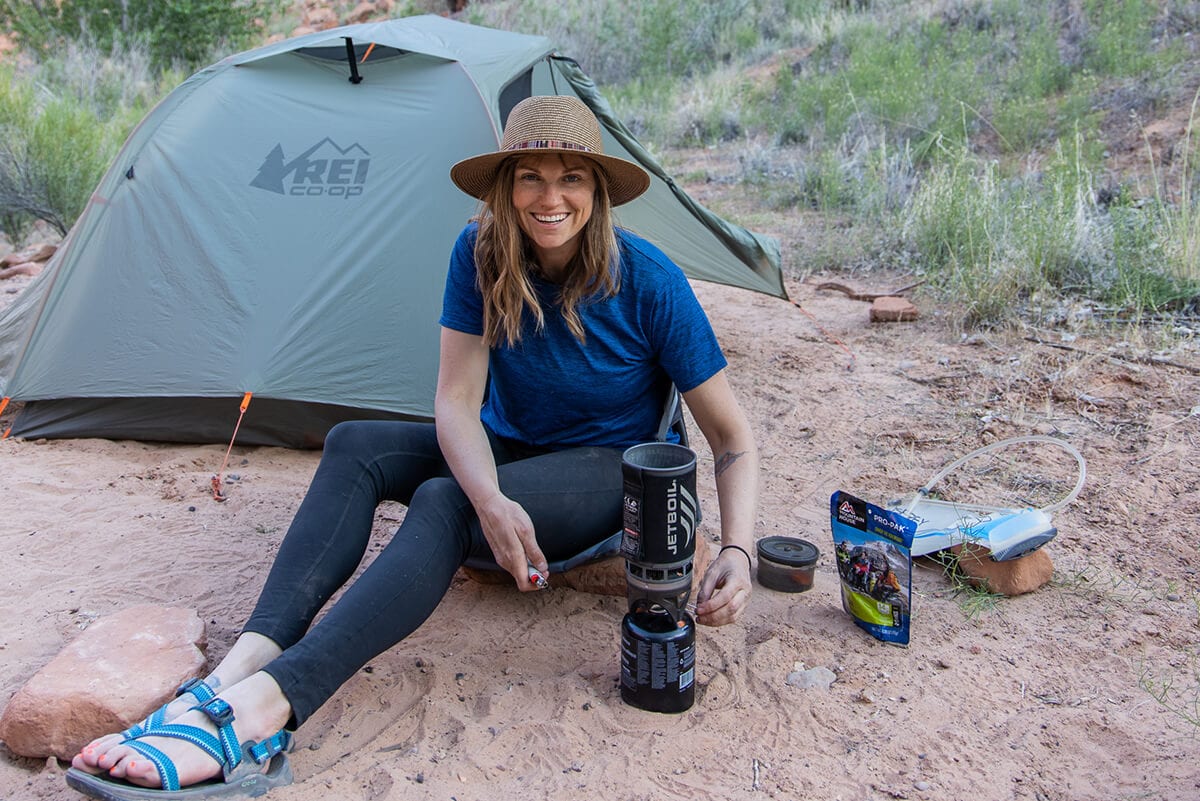
Are you planning a backpacking trip and feeling overwhelmed with figuring out what gear and supplies you need to bring? Don’t worry, you’ve come to the right place.
In this post, we’ll share our ultimate 3-day backpacking checklist (tailored for women) to help ensure you have everything you need for a successful and enjoyable trip.
From essentials like shelter and a comfortable sleep system to practical clothing choices, we’ve thought of all the basic essentials you’ll need to be comfortable on a weekend-long backpacking trip – nothing more, nothing less.
While this is a comprehensive list, I encourage you to adjust your checklist based on your own needs. That being said, I also encourage you to try and stick to the essentials. You may be surprised at how little you need!
The Big Gear Items
These are the essential pieces of gear that should always be on your backpacking checklist for every single trip you plan.
Backpacking Pack
I’ve tried many backpacking backpacks, and funny enough, the least expensive one I’ve owned has also been my favorite.
At 4 lbs. 8.7 oz., the Deuter Aircontact Core 60 + 10 SL Women’s Pack isn’t super lightweight, but it still weighs nearly 2 pounds less than my old Gregory backpack and it seamlessly molds to my body.
Deuter’s Aircontact series packs can adjust for a variety of torso lengths and also comes in a men’s model.
The 60 +10 SL pack is plenty big for a multi-day trip. In fact, this is the pack I took on my 22-day John Muir Trail hike, a 10-day backpacking trip in Alaska, and my Trans Catalina Trail backpacking trip.
For a shorter backpacking trip or if you’re splitting carrying gear with a partner, check out the smaller 45 + 10 SL version. This version is what BFT Director Linda uses on backpacking trips.
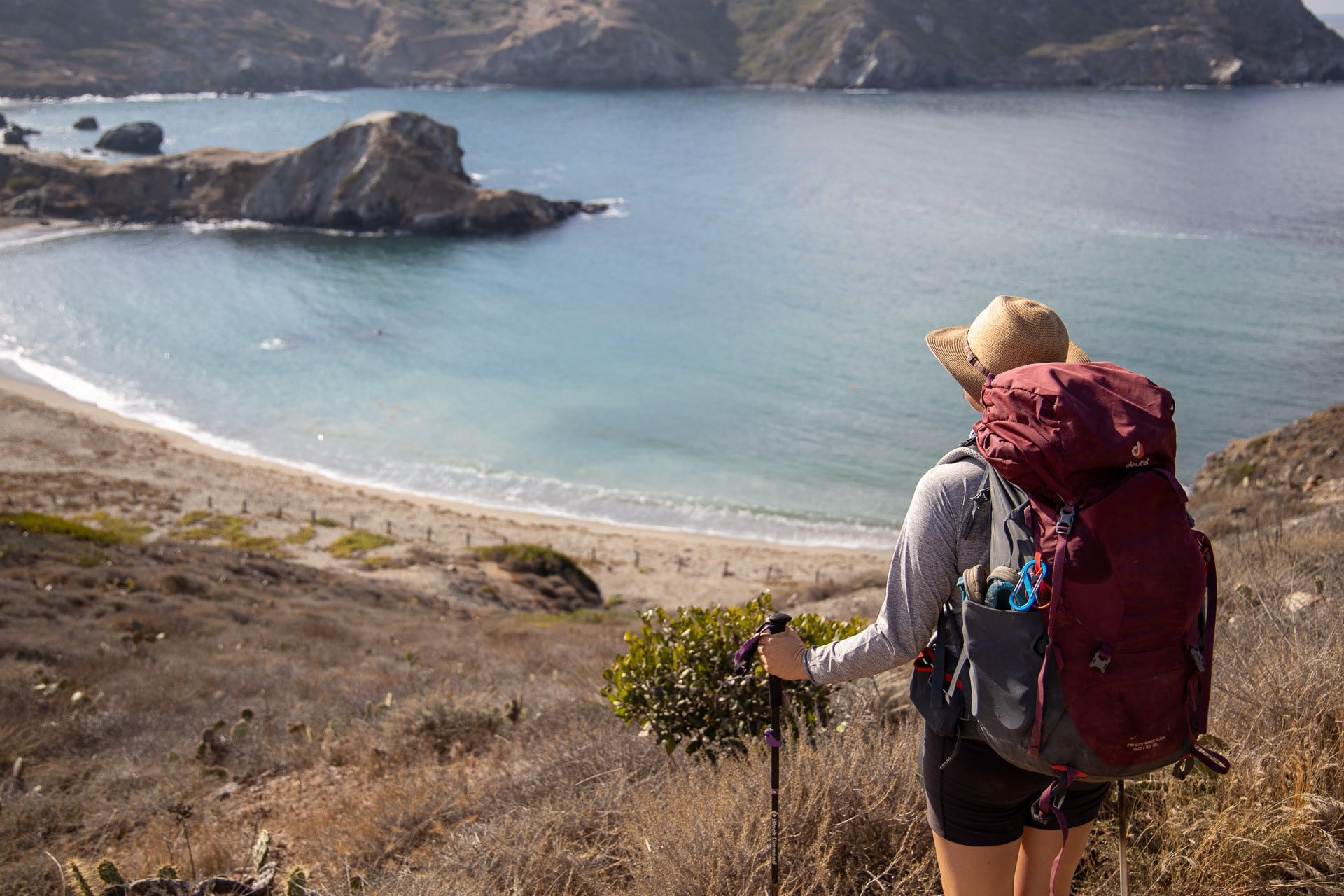
Backpacking Tent
Your tent choice can make the biggest difference in weight out of all the big gear items. However, the lighter your tent, the more money you’ll spend.
If you know you’ll be doing a lot of backpacking, I recommend investing in a good-quality, ultralight tent like the Zpacks Duplex. At just over 1 lb 5 oz, it’s one of the lightest tents on the market yet still roomy enough so you don’t feel like you’re sleeping on top of your partner.
It’s important to note that this Zpacks Duplex is a semi-freestanding tent. It does require two trekking poles (or the Duplex Flex Kit) and guy lines (included) to set up.
If you would like more room or backpack with a pooch, the Zpacks Triplex is just a half-ounce heavier and gives a bit extra space. My partner Ryan and I use the Triplex for backpacking trips which fits us and our 2 dogs, Charlie and Gumbo.
Read next: Interested in the Zpacks Duplex, but want to learn more? Head over to our detailed review to see if it’s the tent for you.
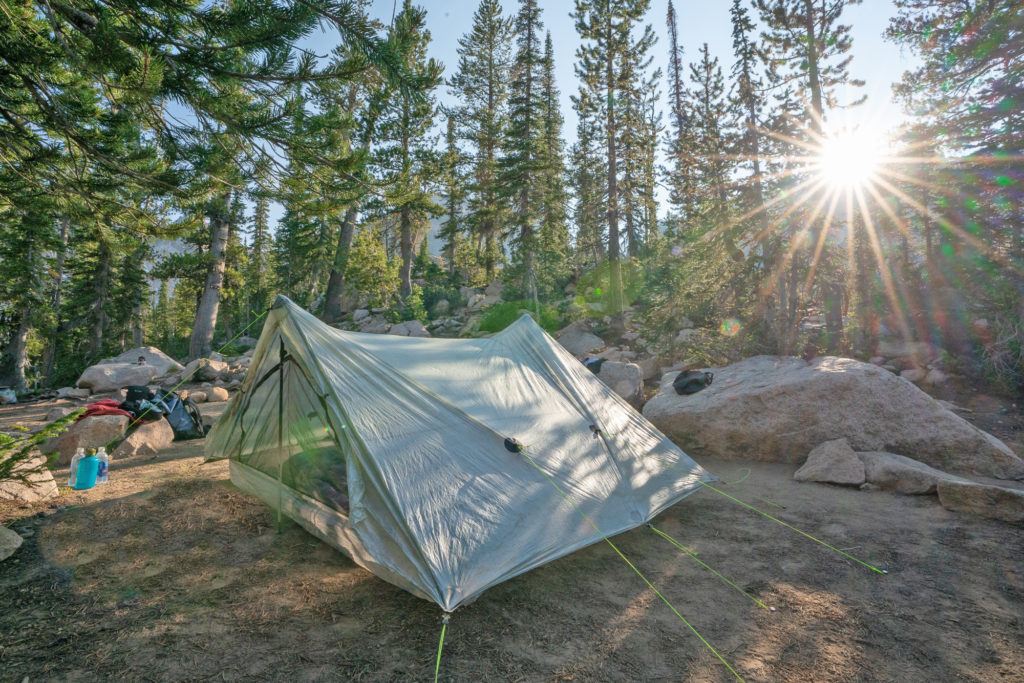
If $600+ is too much to spend on a tent (we don’t blame you!) or you want a freestanding tent, the REI Half Dome SL 2+ is a more budget-friendly option. It is a few pounds heavier at 3 lbs 15 oz, but still a great lightweight option.
Sleeping Pad
I currently use the women’s Sea to Summit Comfort Light Sleeping Pad and love it. It’s lightweight, packs up small, and still manages to be warm and comfortable.
It’s also easy to inflate and comes with a pump integrated into the stuff sack, and it’s made out of durable ripstop nylon.
There’s a unisex version too in case you want something a little bigger.
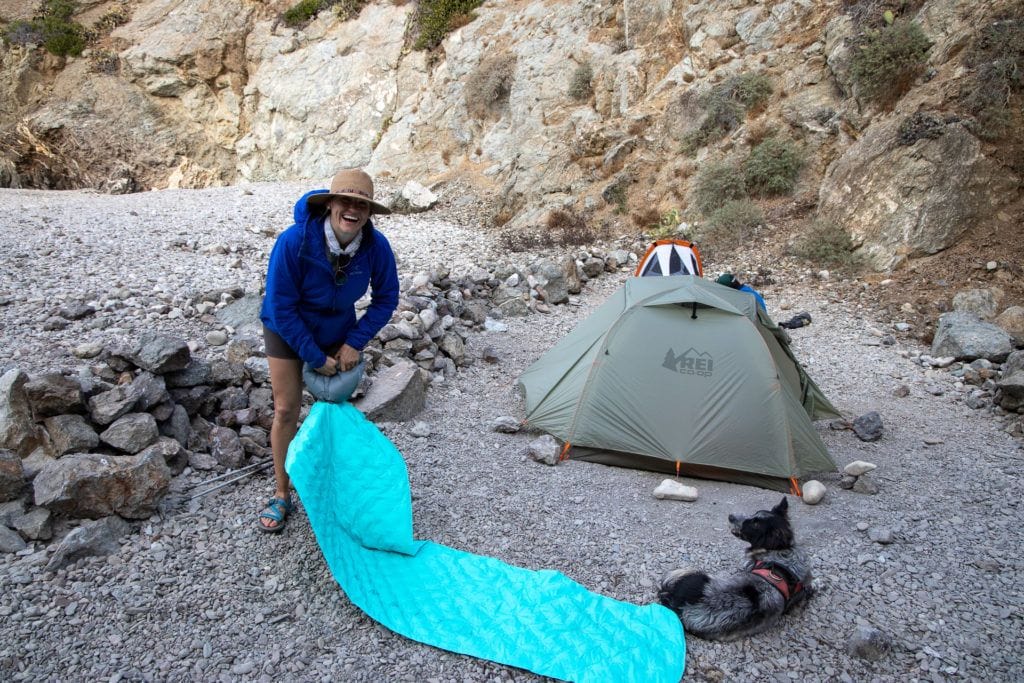
Sleeping Bag
More and more backpackers are opting for quilts over sleeping bags because they are more lightweight and versatile yet still keep you nice and cozy at night.
The Enlightened Equipment Revelation Quilt is our pick for a backpacking quilt. It’s incredibly lightweight at 1 lb 3 oz (850-fill, 30-degree) and we also love that you can customize it to your needs and preferences.
When ordering, you can choose between 850 and 950 fill power, select a temperature rating between 0 to 50-degree, and even customize your quilt length.
The Revelation Quilt is truly a revelation and one piece of gear I don’t leave at home when I’m heading out on a multi-day trip.
If you’re backpacking with your partner and prefer to cuddle, check out our post on the best double sleeping bags for backpacking.
Read More
More Big Gear Items
Backpacking Accessories
There are tons of backpacking accessories you can choose to pack, but here we list the most important ones that will keep you safe and comfortable on the trail.
Trekking Poles
On those uphill climbs, trekking poles help take some of the weight off your hips and legs by utilizing your arm strength. On the downhill, they help ease the pressure on your knees. And on those stream crossings, these puppies have saved me more times than I can count by helping me balance.
The Black Diamond Distance Carbon Z Trekking Poles are Black Diamond’s lightest foldable poles made of carbon fiber and come in 4 sizes to meet your height.
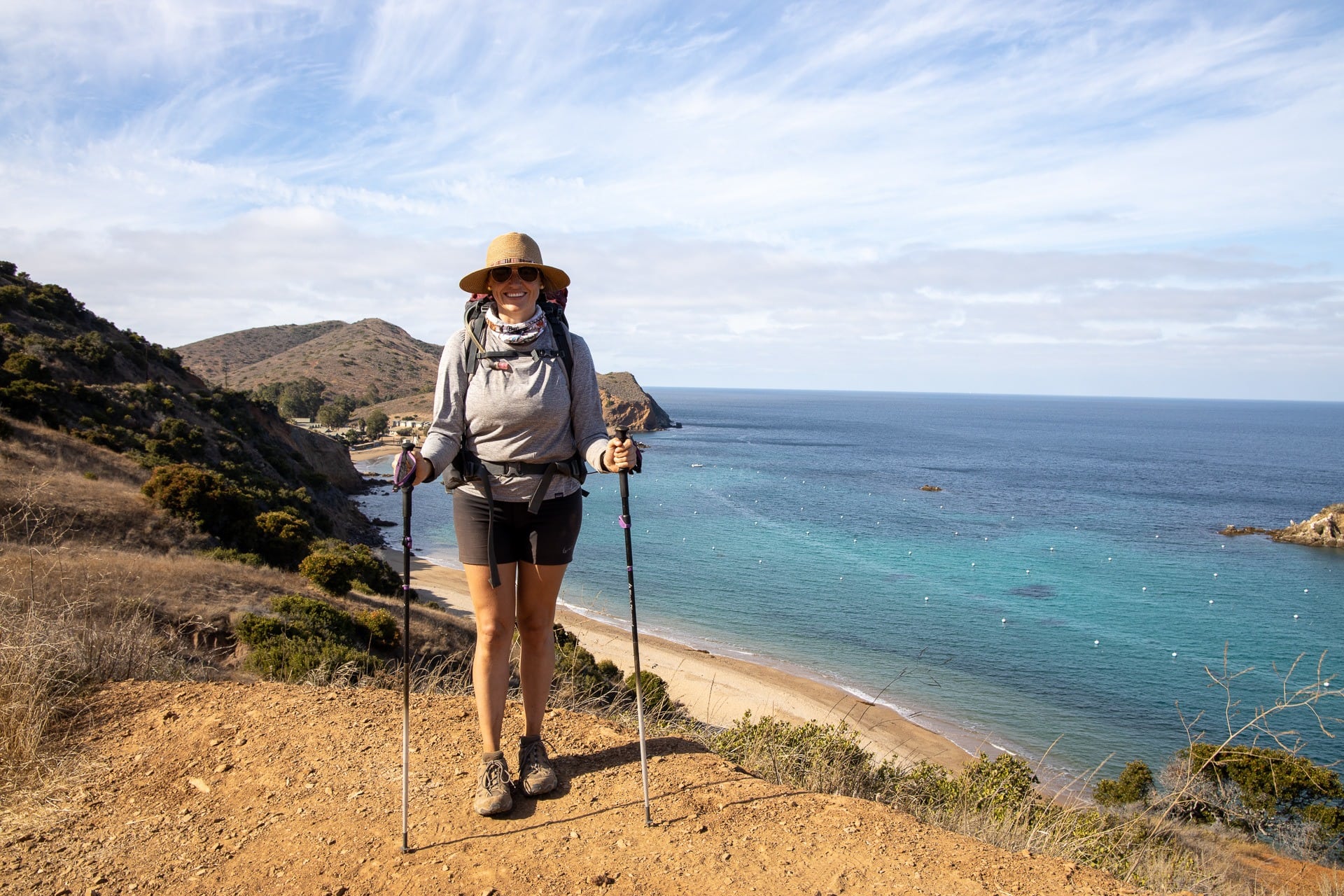
Headlamp
The BioLite Headlamp 325 is my new go-to headlamp for backpacking. It’s ultralight, low profile, and very bright with four lighting modes including red light so you won’t blind your basecamp buddies or compromise your night vision.
I also love that it is battery-free and USB-chargeable (just be sure to fully charge it before you head out!).
Emergency Communication Device
I like to carry a tracking device with me that I can use to send a help signal in case of an emergency.
The Garmin inReach Mini 2 allows for two-way custom texting and also has GPS that you can use for navigating.
The Mini is much smaller and lighter than the regular Garmin inReach so I prefer it for hiking and backpacking when every ounce matters.

First Aid Kit
You should always have a first aid kit when you are hiking in the backcountry. This ultralight, waterproof medical kit comes with the minimum supplies that you will need to address minor wounds, as well as travel-sized packs of some handy medications. I
In addition to what comes in this kit, you should supplement it with some extra blister band-aids and any medications that are specific to the hikers in your group.
Read next: Prefer to put together your own medical kit? Read our guide on How to Build Your Own First Aid Kit.
Backpacking Chair
Packing a lightweight chair is definitely not essential for a backpacking trip, but it’s a nice-to-have item if you plan to spend a lot of time relaxing at camp. The Helinox Chair Zero packs down to roughly the size of 2 Nalgene water bottles and weighs only 1 pound, making it the perfect luxury item.
Read More
Camping Accessories
Backpacking Kitchen Gear
Next on our backpacking checklist is your camp kitchen gear. I tend to keep my cooking setup simple when backpacking. I mainly boil water for coffee or tea and oats in the morning and for backpacking meals in the evening.
Backpacking Stove & Fuel
The Jetboil Flash Cooking System is the most efficient backpacking stove I’ve found, especially if you are only boiling water.
Together, the stove and pot only weigh 13.1 oz. For a 3-day trip, one 230-gram fuel canister (sold separately) should be enough if you are using your stove for coffee, breakfast, and dinner.
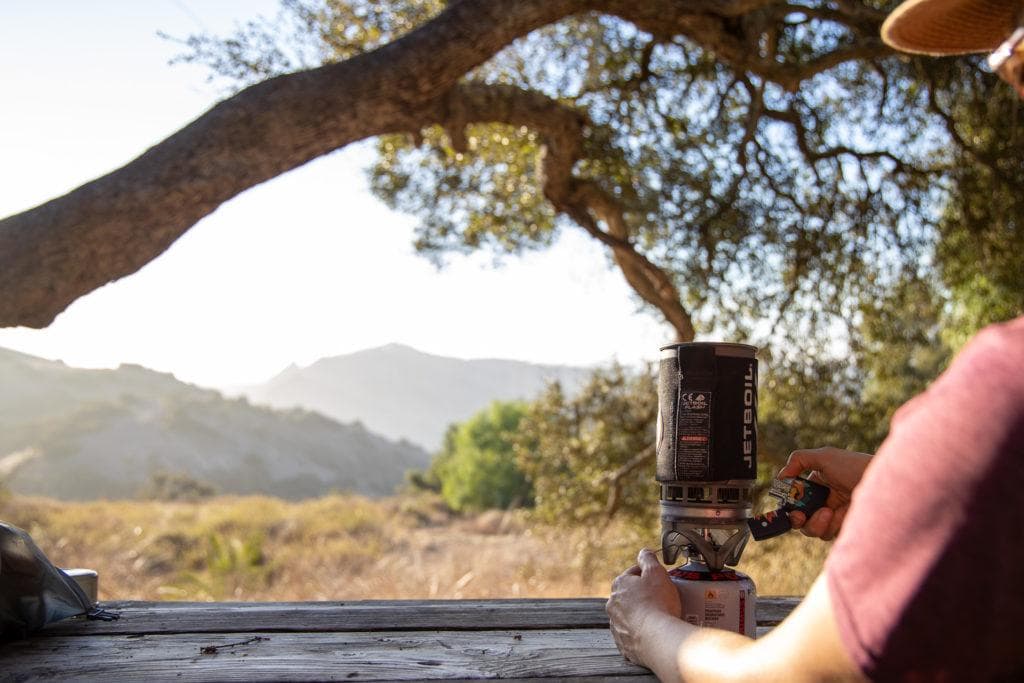
Water Bottles or Hydration Reservoir
I like to pack a few of these lightweight Platypus Soft Bottles that can be rolled up when they are empty. Compared to a hard water bottle like a Nalgene, these are much lighter and take up less space when backpacking.
Depending on water availability, I’ll bring up to three of these on my backpacking trips.
I also tend to use these instead of a hydration pack since a reservoir can be a pain to pull out of my backpacking pack each time it needs to be refilled.
But if you like to backpack with a hydration reservoir for easy water access while you hike, the Osprey Hydraulics Reservoir is a great option.
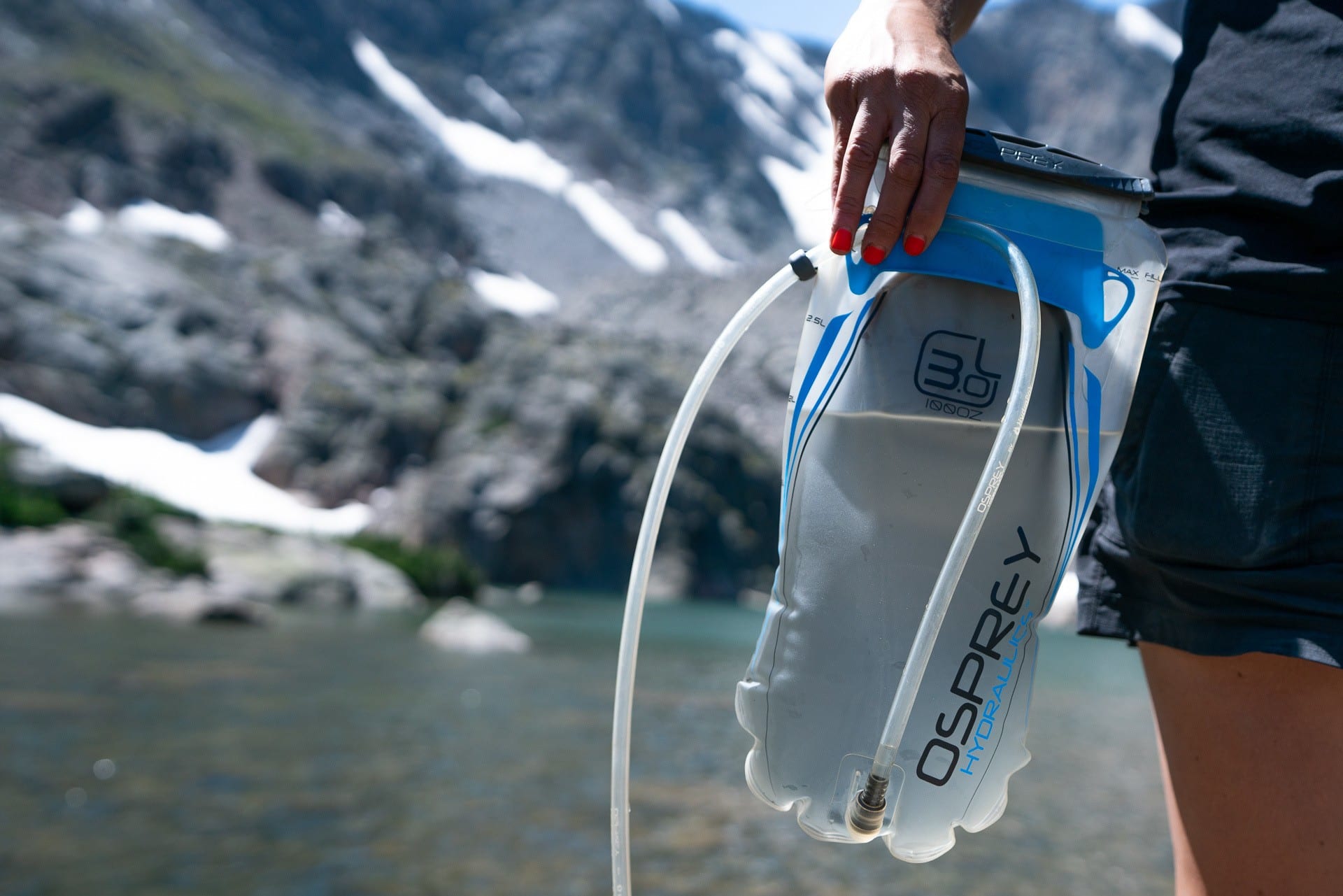
Backpacking Water Filter
The Platypus GravityWorks Water Filter System is absolutely the easiest way to filter your water in the backcountry, in my opinion.
This system relies on gravity to push water through, eliminating the need to pump by hand or manually squeeze water through a filter – meaning you can save your energy for the hike.
At 11.5 ounces you will barely notice this thing in your bag, and what’s really cool is you can connect the hose directly to your water bottle or any standard hydration reservoir.
For more details on how it works, read my complete review here.
I’ll also mention that it’s always good to carry a backup in case your water filter fails. These Katadyn Micropur Purification Tablets are great because they are super small and you can just throw a few in your first aid kit.
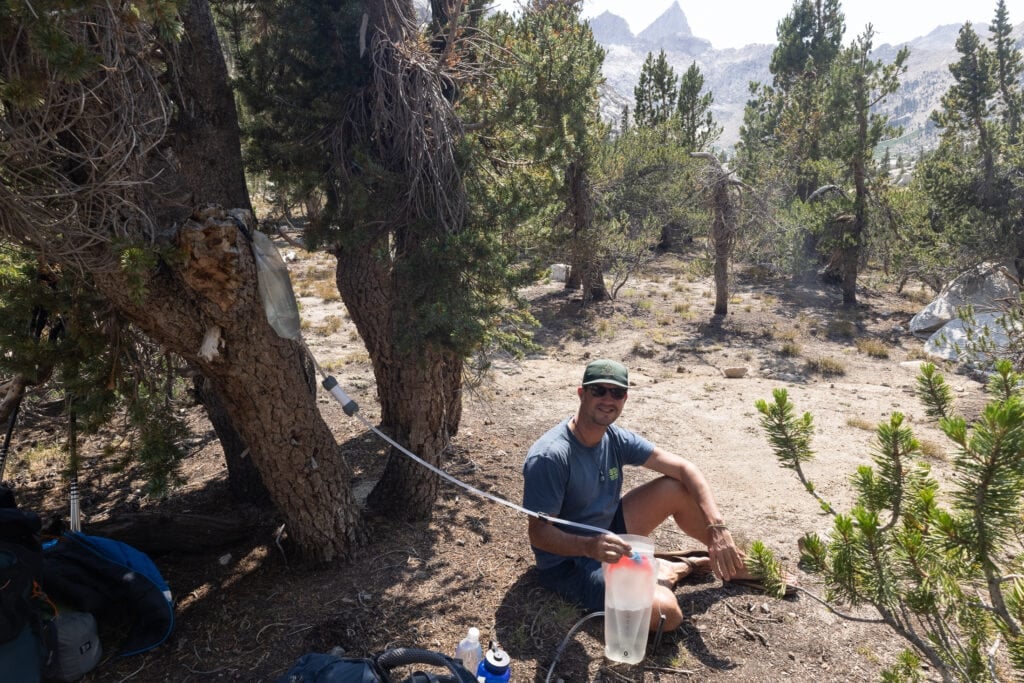
Lightweight Camping Mug
You’ll need something for that morning coffee and evening tea. The GSI Outdoors Infinity Backpacker Mug is lightweight and will keep your beverage warm in the coldest of conditions with its insulated wrap and sip lid. It even has a lightweight fabric strap as a handle.
Eating Utensil
A girl’s gotta eat! Ramen, backpacker meals, oatmeal. This TOAKS Long-Handled Spoon is the only utensil you need, and it weighs shockingly little at 0.65 ounces!
It also has a long handle and can easily reach the bottom of that Mountain House bag.
Knife
Some people like to carry a multi-tool, but personally, I’ve always been able to get by with a simple, small knife.
This Gerber Mini Paraframe Knife can cut paracord or be used to prepare food and only weighs 1.4 ounces.
Bear Canister
You may or may not need a bear canister depending on where you are hiking. They are required by law in California’s Sierra Nevada Mountains, spots in Alaska, Washington, Idaho, Wyoming, and more.
In some places, they may be available for rent but be sure to check before heading out.
If you are on a short trip and only carrying food for yourself, the Bear Vault 450 is a good inexpensive option. Or for a duo or longer trips, go for the larger version.
Read More
Backpacking Kitchen
Backpacking Toiletries
My beauty routine while backpacking is pretty limited and is focused purely on hygiene. That is what I’ve reflected in this backpacking checklist. No deodorant, no makeup, no hairbrush, etc.
Lip Balm
The mountains can suck the moisture right out of those beautiful lips leaving them cracked and dry. Plus, your lips are just as vulnerable to sunburn as your face, so SPF is key.
Sun Bum Mineral SPF 30 has natural, organic ingredients and will keep your lips hydrated and protected.
Sunscreen
At high elevations, you can burn way quicker than you think, and all those hours hiking in the sun add up.
This Sun Bum sunscreen comes in a small tube, is water-resistant, and provides SPF 50.
Toothpaste & Toothbrush
It’s all about those travel-size toiletries when backpacking. This Dr. Bronner’s Travel Toothpaste comes in a 1 oz size and is all-natural, fair trade certified, and the packaging is completely recyclable.
Poop Kit – Trowel, Toilet Paper, & Ziploc Bag
In order to comply with the 7 Leave No Trace Principles, you need to dig a cathole that is at least 6-8 inches deep when you go #2.
You may think “I don’t need a shovel… I’ll just use a rock or stick.” I’ve made that mistake myself only to find that sometimes the dirt is so hard, you can’t dig a hole. And then panic ensues.
Make life easier for yourself by grabbing a BoglerCo Ultralight Trowel. It’s super lightweight and there’s really is no excuse to not bring it with you.
Also, when you go #2, you need to pack out your dirty toilet paper in order to maintain campsite and trail conditions for future campers.
There’s nothing grosser than finding a bunch of used dirty TP when you’re camping. I like to bring a Ziploc bag for my TP and then I store that in a small (not-see-through) stuff sack that I can rinse out later.
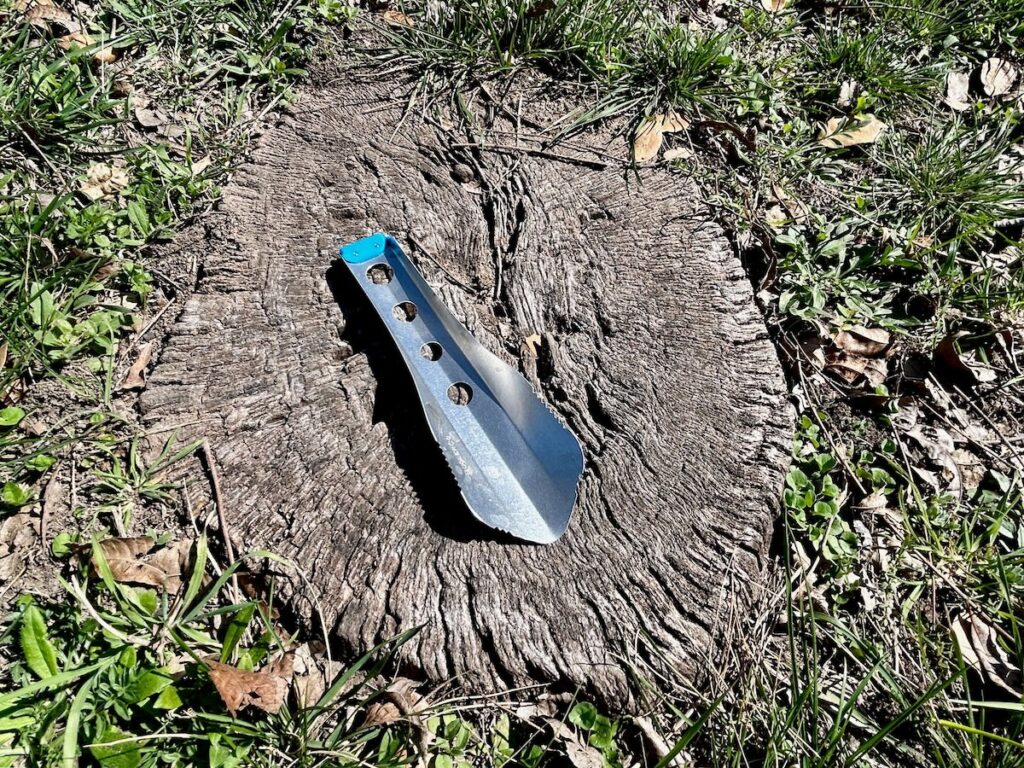
Pee Rag
While this might sound strange to you at first, bringing a pee rag on your backpacking trip, like this specially made, antimicrobial Kula Cloth, is super helpful.
Instead of having to wipe with TP each time and pack it into your zip lock bag, and instead of not wiping at all which can result in odors and discomfort, just wipe with this reusable cloth!
When going to the bathroom, I drip dry and then pat myself off with this in order to keep my lady parts clean.
Then, I use my water bottle to rinse off the towel 200 feet from any water sources (as recommended by Leave No Trace) and hang it from my pack to dry.

Quick Dry Towel
A lightweight quick-dry towel is always handy, whether it’s for drying your hands and face, doing dishes, or going for a swim and doing some sunbathing.
They come in a variety of sizes so you can pack what you need and nothing more.
Hand Sanitizer
A travel-size hand sanitizer is a must before eating and after going to the bathroom while in the backcountry.
I prefer hand sanitizer to soap because it’s easier to follow Leave No Trace. If you do choose a biodegradable soap, like this one by Dr. Bronner’s, be sure to abide by Leave No Trace and rinse 200 feet away from water sources.
Wet Wipes
For shorter trips, you might be able to get away without wet wipes, especially if you’re using the pee rag method and you want to save weight in your pack.
However, if you want a little refresh, these Sea to Summit Wilderness Wipes are soft and gentle on both your skin and the environment. They’re unscented (better for not attracting wildlife) and even come in an extra-large size in case you want to wipe your whole body down after a hot sweaty day on the trail. Be sure to pack them out in your ziplock trash baggie to dispose of them properly.
Backpacking Clothing
How much clothing should you bring on a 3-day backpacking trip? The absolute minimum you need to be comfortable.
You’ll appreciate it when you start to feel the weight of your pack after a couple of hours of hiking.
You really only need 1 hiking outfit and 1 set of dry, warm clothes to change into when you get to camp and for sleeping.
The only thing I bring extra of is underwear and socks and maybe an extra shirt I can swap out depending on how many days I’m backpacking.
Helpful Tip
Avoid Cotton
When backpacking, you want to avoid cotton because it retains moisture, takes a long time to dry, and tends to harbor smells. Instead, opt for quick-dry materials that wick sweat and resist odors.
Insulated Jacket
A lightweight, packable, insulated (down or synthetic) jacket is key for when the temps drop in the evenings.
I prefer something with a hood so I can keep my head warm when it’s windy or extra cold, so I pack my Arc’teryx Atom Hoody.
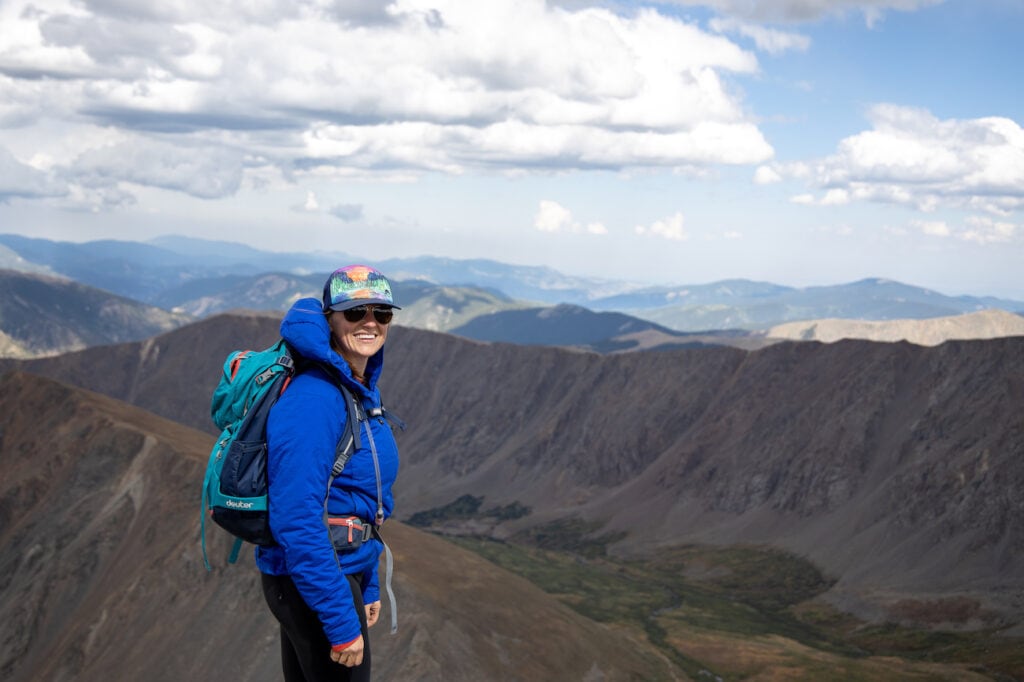
Rain Jacket
Always check the weather before you set out. Even if it’s looking like nothing but sun, I like to bring a lightweight rain jacket and the Arc’teryx Beta AR Rain Jacket is my top pick. It is definitely pricey (catch it on sale!) but once you invest in a piece like this, you’ll have it forever. It’s the rain jacket I wore on a backpacking trip in Alaska where it rained nearly every day.
For a more budget-friendly option, check out the REI Co-op Ranier Rain Jacket – it’s what Linda, BFT’s Director of Operations, currently uses and loves.
Also, if there is any chance of showers, I throw in a pair of rain pants too.
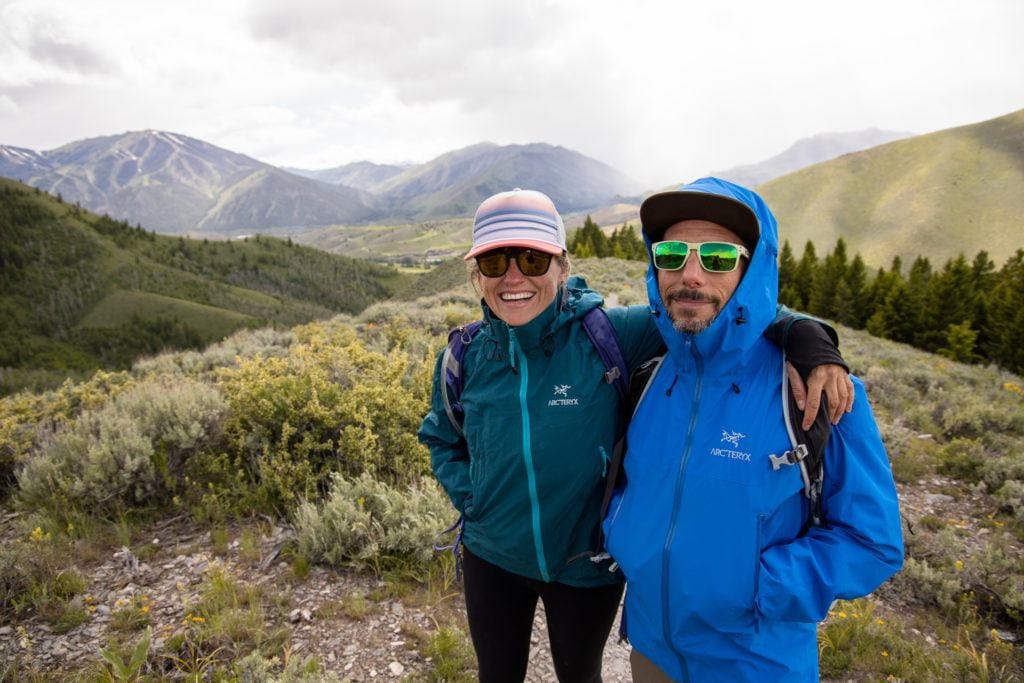
Base Layer Top
A warm, wool base layer is handy for changing into when you’re ready to get out of your sweaty hiking clothes and get warm at camp. It can be cozy to sleep in too.
I like the Icebreaker 200 Oasis Half Zip because it’s super soft and odor-resistant. I also opt for Icebreaker over other Merino wood brands because they have strong animal welfare standards.
Hiking Pants
I prefer to backpack in leggings (if it’s too cool for shorts that is). The REI Flash Hybrid Tights are a Bearfoot Theory team favorite because they’re designed specifically for hiking with thoughtful details such as snag-resistant fabric, a zippered pocket for keys, and a comfortable high-rise waist that won’t dig in or roll down while you’re hiking.
Moisture Wicking T-Shirt
I always hike in a non-cotton, quick-dry, moisture-wicking t-shirt, and most often it’s the Patagonia Cool Capilene T-Shirt.
As I get older, though, I’m preferring the long-sleeve version because it provides more protection from the sun. These shirts are lightweight, so even with the long sleeves, I stay nice and cool.

Hiking Shorts
I like to backpack in spandex shorts when the weather’s nice, but lately, I’ve been liking these REI Co-op Active Pursuits Shorts.
They’re comfortable and stretchy and offer a little more breathability than spandex.
Sports Bra
Sports bras are my go-to even when I’m not hiking, and these days I’m personally loving the lululemon Run Times Bra.
It’s perfect for backpacking because it doesn’t shift around, my breasts are fully supported, and don’t bounce around AT ALL. I also love the thick straps becuase they don’t dig into my shoulders.
Quick Dry Undies
The lululemon InvisiWear Mid-Rise Boyshorts are lightweight and have a barely-there feel, making them great for backpacking.
I’ve tried two other cuts of these InvisiWear underwear, and the boyshorts stay in place the best out of all of them.
Hiking Socks
I alternated between 2 pairs of Darn Tough Hiking Socks on my John Muir Trail hike. That was years ago, and I still wear these socks hiking.
They are extremely durable and stay put while you’re hiking so you don’t end up with nasty blisters. Plus, Darn Tough offers a lifetime warranty. Free socks for life!
Hiking Boots
I’ve always been a big fan of Oboz and recently upgraded to a new pair of Bridger BDry Hiking Boots after wearing my last pair out through years of hiking and backpacking.
The mid-height helps support your ankles, plus they are waterproof and have a stiff sole, so you get plenty of support on those steeper, rockier slopes.
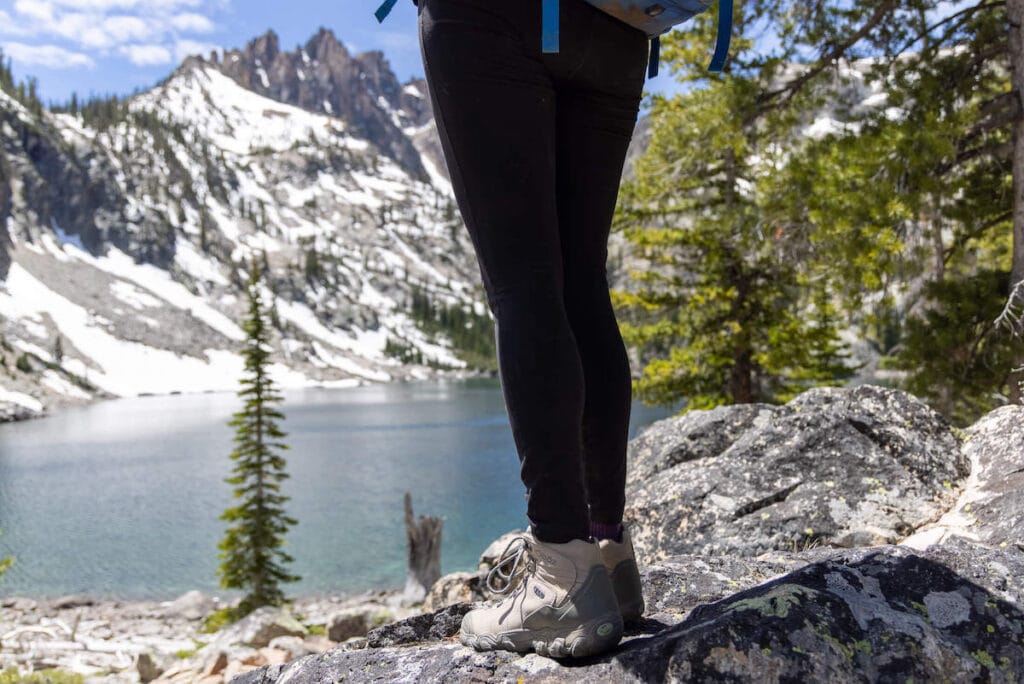
Camp Sandals
It’s always nice to take those hiking boots off when you get to camp to let your feet breathe, and for that reason, a pair of camp sandals are a must on my backpacking checklist.
These Teva Universal Trail Sandals are lightweight (1 pound for the pair) and provide structure and grip for walking around camp.
They have padding around the ankle and anywhere there is a buckle to prevent rubbing, and they are one of the most comfortable pair of sandals I’ve ever owned.
Plus, they are made from recycled water bottles, so it’s a win-win! See my full review here.
Sun Hat
Even if you’ll be hiking in the woods or the forecast looks cloudy, you’ll want to bring a sun hat to protect your face, neck, and shoulders from harmful UV rays. Not only do hats ward off sunburns, but keeping your skin shaded can also help prevent dehydration and heatstroke.
The Wallaroo Sedona Hat has been my favorite for years. I love the wide brim, stylish look, and that it can pack down without losing its shape.
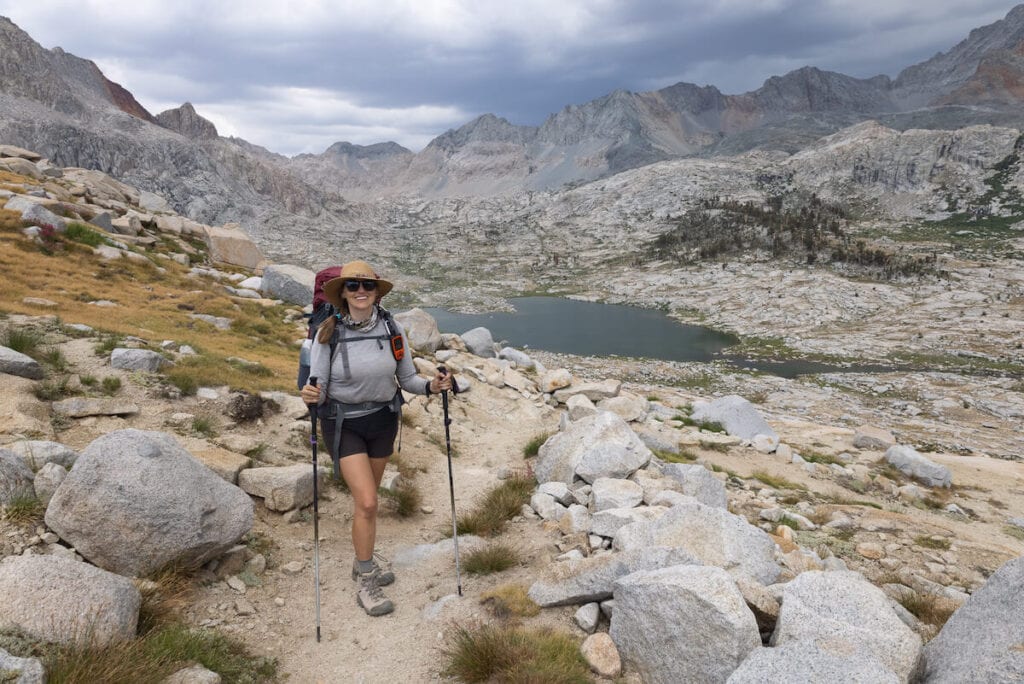
Sunglasses
Don’t forget your shades at home! You probably already own a pair of sunglasses, but if you’re in the market for some new backpacking sunglasses, Goodr makes fun, affordable options. We also love that they are a member of 1% For The Planet.
Buff
I also highly recommend packing a buff – a versatile piece that you can wear around your neck for sun protection, around your face and ears if it’s windy, and even as a headband soaked in water to help keep you cool.
Gloves
If it’s going to be cold, you’ll also want to bring a pair of gloves. I like these lightweight Smartwool liners. They’re touchscreen compatible and not bulking, so they work well with trekking poles.
Beanie
It’s a good idea to pack a lightweight, quick-drying beanie to wear at night or if temps drop during the day. The REI Ribbed Beanie is a simple hat that does the trick.
Read More
Backpacking Clothes
READ NEXT
Need help planning or preparing for your trip? Check out these helpful backpacking how-to guides:
Save this post to Pinterest
What’s on your backpacking checklist that we missed? Is there anything you’d add or subtract? Do you have any questions about what to bring backpacking? Let us know in the comments below.


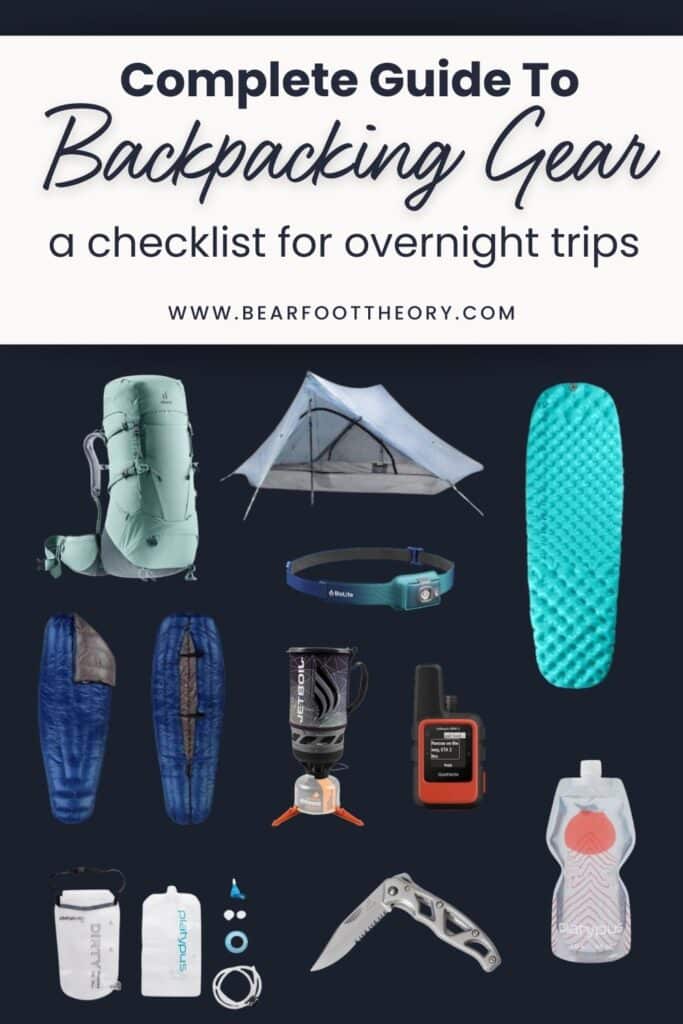
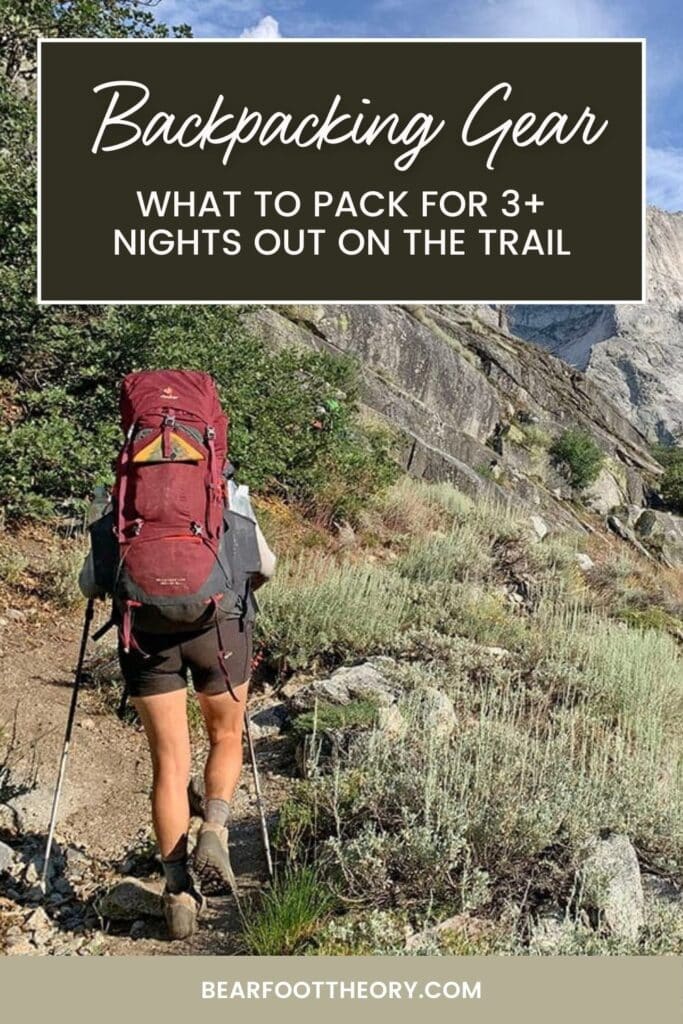
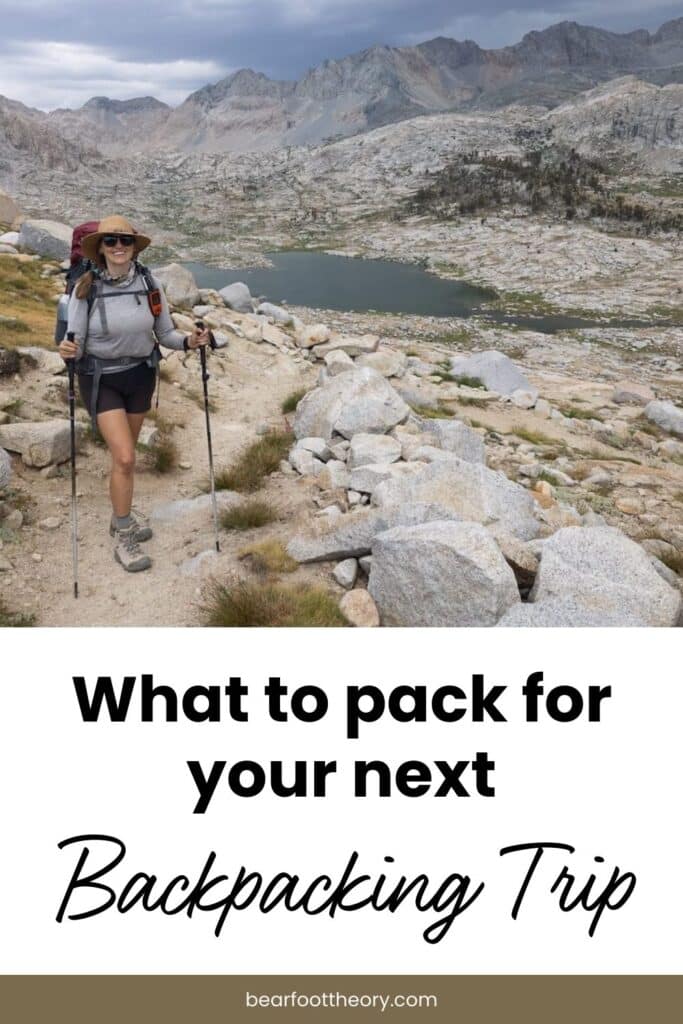
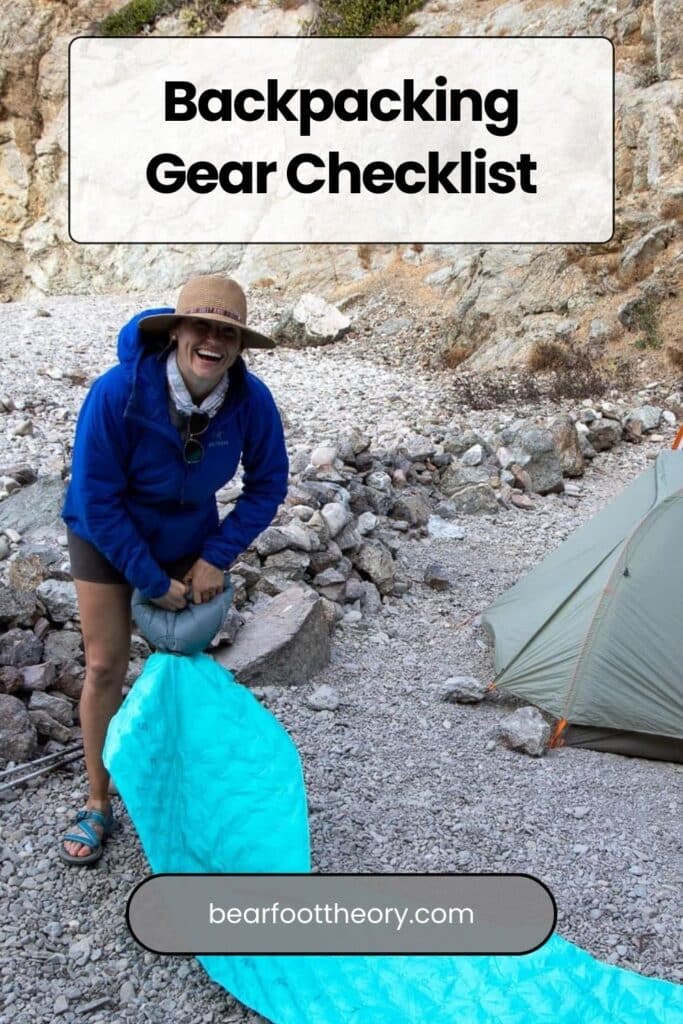
Pretty nice list! I need to have a look at the Nemo sleeping pad, my Thermarest is annoying me so much recently.. Need something light and rectangular.
I’m totally with you re: trying to find a comfortable and convenient way to carry photography gear. Have you tried the Peak Design capture clip? I’ve used it for day hikes and have liked it so far but am not sure how it will work for weekend backpacking trips. Of course, even with the clip you’d need some decent bag for protection if you’re going through rough terrain or if the elements don’t cooperate. I like your approach with the sling though. 🙂
I have tried the Peak Design clip. They are pretty cool and I might be taking one with me on my upcoming trip to Nepal.
Check out Cotton Carrier’s Strapshot camera holster for your DSLR. It wraps around your backpack shoulder strap and provides a secure place to hang your camera with a 1/4 turn quick release and safety tether. I use it and have the full chest harness.
(I’m not at all associated with them, just find their gear really convenient.)
Thanks for the good read.
I also use the cotton carrier system – a disc screws into the tripod attachment of my camera (I pack in a Sony a6000 with an 18-200mm lens) and then there’s a holster that clips/velcros on to my backpack strap on my shoulder. You keep the strap around your neck for safety (more than twice I’ve been over, the camera unhooked from the carrier and I would have dropped it without the neck strap!) and then the camera is easily accessible when you want to shoot something. The downside is no protection from dust/moisture, so on dusty trails I’m brushing off the lens a lot. But it went with me to Everest Base Camp, Kilimanjaro and numerous 2-7 day backpacking trips with a large ziplock in my bag for water protection if needed. Love this setup.
I love my cotton carrier. I carry a full sized Nikon on it..have for 3 years… zero accidental disconnects… its tough for a piece of plastic too….
Great list Kristen, these checklists are so handy for people that are new to doing these kind of hikes.
Have a great holidays!
Stephen
– Uncharted Backpacker
This is an awesome and very specific list! It’s very helpful you listed brands that you specifically like to use!
Just got the Montrail hiking boots. Loving it so far. Great list.
I THINK I obtained permits for Havasu Falls for this spring (I received confirmation emails, but still have a fear something may go wrong, but I’m hoping for the best). Starting to plan and struggle with what camera equipment to bring. I have a Nikon d7100 that I love, but would like to get by with just my 35 mm/1.8 lens. Think that’s wide enough to get good waterfall shots?
Hey Des, I’d highly recommend a wide angle lens. I brought a 16-35mm last time and it worked out perfectly. Have fun!
Amazing list! Seems to be the go-to stuff when comparing to other lists. That said, I\’d strongly suggest bringing a compass and map! On a longer trip would you change change the gear or simply bring a few more items of clothes?
Thanks Sean for the added recommendation of a compass and map! For a longer trip I would just recommend having at least one change of clothes in case of weather or for added layering. I backpacked the entire PCT for 5 months with only 2 shirts and 2 pairs of bottoms, so you definitely don’t need to expand on bringing more items necessarily.
A great list and this is going to be so useful to me. I go on treks very frequently and usually don’t get much time for backpacking. Thanks a lot for posting!
You literally just saved my life. Thank you for making this list!
Its always good to have a small extra knife just to be sure and ready for everything. A roadeavour knife wont add that much. only a size of a credit card. but very reliable.
Also a good thing to have is a collapsible water bottle like the one in roadeavour
n NZ if I went hiking with an umbrella, I would be laughed out of the hills. It would be really good to see exactly what you take in all the small bags, as this is wear weight accumulates and my pack gets heavy. Thanks for sharing.
Hey man, this is a very specific and a great list. Thanks for sharing with us such a awesome list.
Great list Kristen. Thanks for taking the time to put this stuff together. Your site is full of great info. I do the same stuff on a much less professional level on my youtube channel. Your site always has a few gems that even experienced hikers can find useful. Keep up the good work!
Thanks good stuff
Wow you hit the lottery? Most hikers couldn’t afford have your list. Anyone can go into a REI and buy the best available but a true backpacker can use whats handy and go on a trip. I am an assistant scout master for a Boy Scout troop and do trips including gas for a 3 hour trip, food for 12 and snacks for around 12 bucks each using basic gear for 3 days on the trail. Contact me and I can teach you how to hike on a tight budget.
I am so grateful to have stumble across your website. I am a beach bum. I have only done one day hikes. But, I have been invited to a three day hike in Korea. I will be doing the Jirisan Nature Reserve over three days. I have a bag and sleeping bag. That’s it. What elae do I need to prepare for this three day trek? It will be in September. Your help would be appreciated. I am an Expat teaching in Korea. I am exploring Korea through Hikes and wone tasting. I am open to suggestion.
Hi Gabriela, we are so glad you found us! Will you need a tent for your trek or will they be provided? We would recommend a sleeping pad as well. If you’d like to reach out and email us at contact@bearfoottheory.com we can provide you with additional links to great articles and packing lists on our site to help you prepare for your trip. Sounds like an incredible adventure you have ahead of you!
Just what I was going to say. This is nice list of gear for anyone who has, say, a couple of thousand dollars to drop on a three-day (two-night?) backpacking trip.
What is your total weight of your pack?
Hi Rolando, that really depends on how long you are going to be backpacking. For a 3-day backpacking trip, we recommend trying to keep your pack weight as minimal as possible, depending on if you need to carry water or not. A good rule of thumb is not having your pack weight more than 20% of your body weight.
It is interesting that trekking poles can help manage the weight on your hips and legs by using your arms. My wife and I are going on our first backpacking trip in three months and we are trying to get everything together. We may consider going to a few camping stores near us to see what they recommend we bring too.
Hi James,
So exciting to hear you and your wife are getting into backpacking! Trekking poles are a game-changer on the trail. We have a ton of comprehensive blog posts here about backpacking that you’ll probably find helpful. I suggest you start here: https://bearfoottheory.com/backpacking-101/ Let us know where you go and if you have any questions!
On my must pack list is a brightly colored bandana or two. So many uses; shade, neck warmer/cooler, dishrag, splint maker, wash rag, hunter safety gear (thus, brightly colored), and on and on. Thanks for great list, Kristen!
My thoughts, exactly…Black Diamond everything! If I’m going to spend $1000, might as well be in a hotel. There are countless other, just as good, options out there. Off-Brand does not always mean that you are compromising durability and/or performance. Do yourself a favor and think logically–don’t always believe sites like this. Some great info in here, I’ll agree, but focus on being “prepared,” and not showing off at the trailhead as you unload from your Volvo.
Ho! these are some really good checklist, thanks for sharing 🙂
Thank you. I will try everything on my first hike this fall.
Thanks for reading, happy hiking!
What are your thoughts on a woman hiking solo? Safe?
We thinking hiking solo as women can be done safely. In fact, it can be fun and empowering. Check out this blog post for more on this topic as well as safety tips for solo hiking: https://bearfoottheory.com/hiking-alone/
Thanks for this list, I’m planning out my first backpacking trip for myself and my husband and struggling to find a minimalist approach! I don’t want to pack everything and the kitchen sink but every blog seems to have twenty million things that are unnecessary. I’m looking forward to following your list! Any tips on seating? My husband is struggling with not being able to pack his giant camping chair.
Hi Claire – we know what you mean! Taking only what you need to be safe and comfortable will help you have a better experience. If you’re suffering under the weight of your pack it’s hard to have a good time. The Helinox Chair Zero in the blog post below is a good option. It’s super lightweight and packs down small making it great for backpacking. The REI Trail Chair in the same blog post is a good option as well if you don’t mind sitting on the ground. Another option is a lightweight, folding stool (just search “camp stool” online and you should be able to find a few options). Happy hiking!
https://bearfoottheory.com/best-camp-chairs/
Look up thermarest trekker chair. It converts/folds your sleeping pad into a sitting position.
That’s a great suggestion, thank you!
I will definitely keep this in mind in my next travels. thank you!
Thanks for reading!
What is your total weight including pack for 3 days?
Also check out Lume deodorant on line. Some folks can go 72 hours with out stink. Safe for any body part. And no I don’t work for Lume, just having great results.
It varies depending on a few factors including the weather (how much warmth, rain gear, and shelter we have to pack for example) and whether a bear canister is needed which adds a little weight as well. I’d say our standard pack weight is anywhere from 15-30 lbs depending on how lightweight we’re going. And thanks for that deodorant recommendation!
Hi, thanks for taking the time to write these articles and share them, much appreciated. I have shared them on my own webpage/blog with my own followers as well – spreading the love.
Thanks Tania!
I was meant to find this post. I am a woman about to go on my first 3 day hiking/backpacking trip. I can’t tell you how helpful this info is. Thank you so much!
You’re welcome – happy trails!
The point is that if you’re looking to list existing products – it pays to ensure that you’re using the most effective techniques to instill trust, desire, and confidence in your buyers.
I love the mansplainers out there shaming her for touting nice gear. We all like to spend on different things. Some of us might go to REI to pick up a fun toy or two, and the rest of us probably have the brains to know how to substitute a cheaper item or repurpose something we have. First timers can also borrow gear from friends or neighbors before they commit to more frequent backpackers. It’s a great way to figure out what you like. This list was very helpful, Kim. Thanks.
Where’s your straw hat from though?? So cute!
It’s a Wallaroo Sedona Hat. My favorite wide-brimmed hat!
As others have said…THANK YOU. I have not backpacked in 8+ years and this was a great reminder and check list. I actually cannot believe some of the folks who harassed you about buying quality gear…guess their Momma never told them that “if you can’t say something nice, don’t say anything”…you would think they would have learned that on the trail. Their packs must get heavy carrying all that hate around…lose the weight! Franklly, I am always looking for ways to time weight and cost, but that is part of the fun and the process. Thanks again for a great list/refresher as I plan a 3 day in the Smokey’s!
So glad to hear you found this helpful! Enjoy your trip to the Smokey’s, and welcome back to backpacking! We actually have a fall travel guide for the park here in case you need help planning: https://bearfoottheory.com/smoky-mountains-fall-guide/
This is a very nice list, but if you put all these things together, the weight is not going to be ideal. The tent and sleeping bag is just about 6 lbs for start. All these are good products, but for the weight conscious, I would definitely be going for lighter items, if you don’t mind the weight, great list.
Hi Nikki, thanks for the input! These are the gear items we’ve personally carried when backpacking, even though they might not be the lightest on the market. For someone just starting out, buying gear can be really expensive so we’ve tried to strike a good balance between cost and weight in our recommendations. However, we’re working on an ultralight backpacking gear guide at the moment which will focus more on lightweight items.
Do you have an article on what you pack for food for a three day hike? I have always day hiked, and know my go to list for snacks, but haven’t ever done overnights, so not sure what to bring for calorie packed real meals. Thanks.
Hi Melanie, this blog post gives tips for what to pack for backpacking food, how much to bring, and our personal favorites: https://bearfoottheory.com/backpacking-food-ideas/